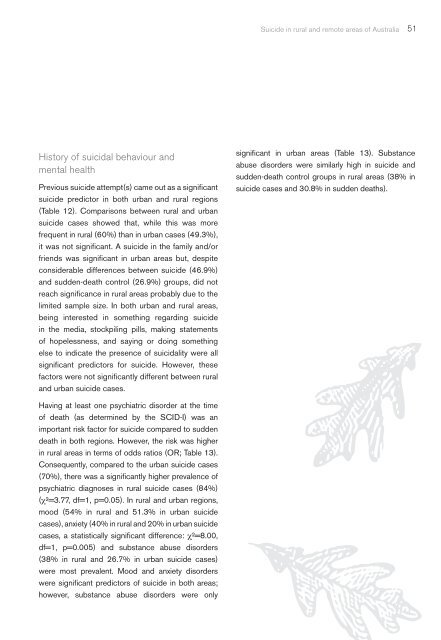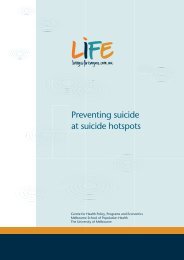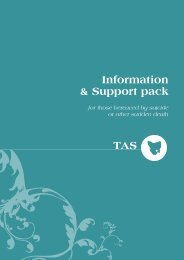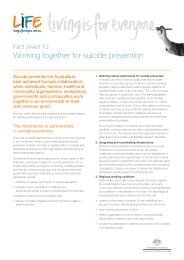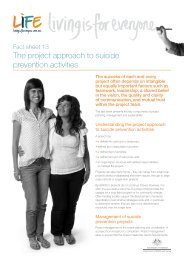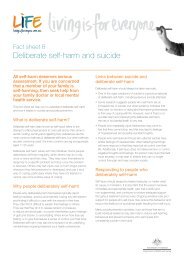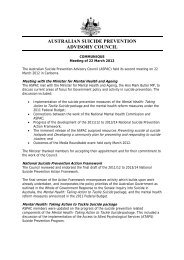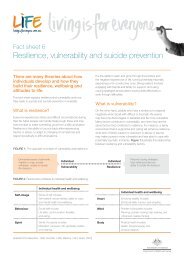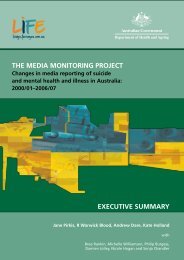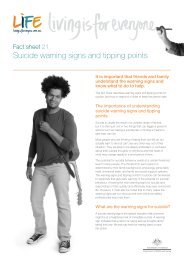SUICIDE in RURAL & REMOTE AREAS of AUSTRALIA - Living is for ...
SUICIDE in RURAL & REMOTE AREAS of AUSTRALIA - Living is for ...
SUICIDE in RURAL & REMOTE AREAS of AUSTRALIA - Living is for ...
You also want an ePaper? Increase the reach of your titles
YUMPU automatically turns print PDFs into web optimized ePapers that Google loves.
Suicide <strong>in</strong> rural and remote areas <strong>of</strong> Australia 51<br />
H<strong>is</strong>tory <strong>of</strong> suicidal behaviour and<br />
mental health<br />
Previous suicide attempt(s) came out as a signifi cant<br />
suicide predictor <strong>in</strong> both urban and rural regions<br />
(Table 12). Compar<strong>is</strong>ons between rural and urban<br />
suicide cases showed that, while th<strong>is</strong> was more<br />
frequent <strong>in</strong> rural (60%) than <strong>in</strong> urban cases (49.3%),<br />
it was not signifi cant. A suicide <strong>in</strong> the family and/or<br />
friends was signifi cant <strong>in</strong> urban areas but, despite<br />
considerable differences between suicide (46.9%)<br />
and sudden-death control (26.9%) groups, did not<br />
reach signifi cance <strong>in</strong> rural areas probably due to the<br />
limited sample size. In both urban and rural areas,<br />
be<strong>in</strong>g <strong>in</strong>terested <strong>in</strong> someth<strong>in</strong>g regard<strong>in</strong>g suicide<br />
<strong>in</strong> the media, stockpil<strong>in</strong>g pills, mak<strong>in</strong>g statements<br />
<strong>of</strong> hopelessness, and say<strong>in</strong>g or do<strong>in</strong>g someth<strong>in</strong>g<br />
else to <strong>in</strong>dicate the presence <strong>of</strong> suicidality were all<br />
signifi cant predictors <strong>for</strong> suicide. However, these<br />
factors were not signifi cantly different between rural<br />
and urban suicide cases.<br />
signifi cant <strong>in</strong> urban areas (Table 13). Substance<br />
abuse d<strong>is</strong>orders were similarly high <strong>in</strong> suicide and<br />
sudden-death control groups <strong>in</strong> rural areas (38% <strong>in</strong><br />
suicide cases and 30.8% <strong>in</strong> sudden deaths).<br />
Hav<strong>in</strong>g at least one psychiatric d<strong>is</strong>order at the time<br />
<strong>of</strong> death (as determ<strong>in</strong>ed by the SCID-I) was an<br />
important r<strong>is</strong>k factor <strong>for</strong> suicide compared to sudden<br />
death <strong>in</strong> both regions. However, the r<strong>is</strong>k was higher<br />
<strong>in</strong> rural areas <strong>in</strong> terms <strong>of</strong> odds ratios (OR; Table 13).<br />
Consequently, compared to the urban suicide cases<br />
(70%), there was a signifi cantly higher prevalence <strong>of</strong><br />
psychiatric diagnoses <strong>in</strong> rural suicide cases (84%)<br />
(χ²=3.77, df=1, p=0.05). In rural and urban regions,<br />
mood (54% <strong>in</strong> rural and 51.3% <strong>in</strong> urban suicide<br />
cases), anxiety (40% <strong>in</strong> rural and 20% <strong>in</strong> urban suicide<br />
cases, a stat<strong>is</strong>tically signifi cant difference: χ²=8.00,<br />
df=1, p=0.005) and substance abuse d<strong>is</strong>orders<br />
(38% <strong>in</strong> rural and 26.7% <strong>in</strong> urban suicide cases)<br />
were most prevalent. Mood and anxiety d<strong>is</strong>orders<br />
were signifi cant predictors <strong>of</strong> suicide <strong>in</strong> both areas;<br />
however, substance abuse d<strong>is</strong>orders were only<br />
GriffithBook FINAL 20/09.<strong>in</strong>dd 51<br />
15/11/12 4:28 PM


